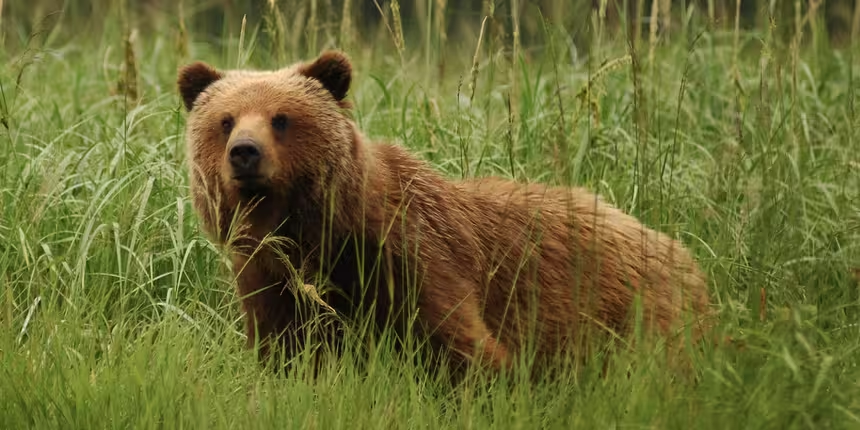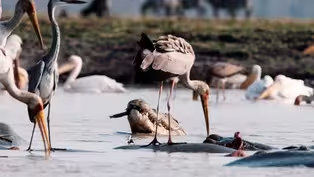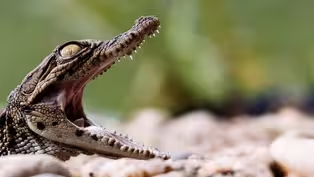
Filming Katavi's Unseen and Remote Wilds
Clip: Season 43 Episode 10 | 15m 43sVideo has Closed Captions
Wildlife filmmaker Owen Prümm ventures into Katavi, a remote region in southwestern Tanzania.
Wildlife filmmaker Owen Prümm explores Katavi, a remote region in Tanzania, documenting its diverse wildlife, including lions, crocodiles and hippos. Facing extreme weather and logistical challenges, his team captures breathtaking stories of survival and interspecies cooperation.
Problems playing video? | Closed Captioning Feedback
Problems playing video? | Closed Captioning Feedback
Major support for NATURE is provided by The Arnhold Family in memory of Henry and Clarisse Arnhold, Sue and Edgar Wachenheim III, The Fairweather Foundation, Charles Rosenblum, Kathy Chiao and...

Filming Katavi's Unseen and Remote Wilds
Clip: Season 43 Episode 10 | 15m 43sVideo has Closed Captions
Wildlife filmmaker Owen Prümm explores Katavi, a remote region in Tanzania, documenting its diverse wildlife, including lions, crocodiles and hippos. Facing extreme weather and logistical challenges, his team captures breathtaking stories of survival and interspecies cooperation.
Problems playing video? | Closed Captioning Feedback
How to Watch Nature
Nature is available to stream on pbs.org and the free PBS App, available on iPhone, Apple TV, Android TV, Android smartphones, Amazon Fire TV, Amazon Fire Tablet, Roku, Samsung Smart TV, and Vizio.
Buy Now

Explore More Ways to Watch
Bring the beauty and wonders of wildlife and natural history into your home with classic NATURE episodes.Providing Support for PBS.org
Learn Moreabout PBS online sponsorship- [Owen] I'd heard early rumors about Katavi.
Mysterious, remote, and inaccessible, a place so unexplored that it seemed like a world from a different time.
But nothing could have prepared me for the reality.
I'm Owen Prümm.
As a wildlife filmmaker, Katavi in southwestern Tanzania sounded too good to be true.
No collars on the animals, very few tourists.
But would there be enough animal stories there to make into a film?
I would have to go and take a look for myself.
(birds chirping) I've been documenting African wildlife for decades, and I was immediately struck by the diversity of animals I found in Katavi, including the largest herds of buffalo I have ever seen, a sure sign of a healthy and undisturbed environment, and very encouraging.
High-flying drones gave me the impression of a prehistoric landscape, and also convinced me that the network of gullies and dongas across the plains were worth exploring.
(wings flapping) Cooperative hunting between species is one of my special interests.
That was happening at another level here.
(water splashing) (birds chirping) I found huge numbers of hippos, (hippo grunting) and that for sure means there will be fighting, which is always dramatic.
(hippos grunting) But I still wasn't sure there was enough of a story to tell.
I quickly realized that among the lion pride patrolling the river, there were some very identifiable characters, a big pride male I called Arthur, and a senior female I named Patch, because of the mark on her upper lip.
Her pregnant daughter, who I called her Werzy, we was going to be worth following, too.
There was something gritty about these lions, with their faces often black with mud.
(tense music continues) They were also tree climbers, which is interesting, but not so unusual, really.
So what was different about these lions, and what was my story going to be?
(lion grunting) It was when I witnessed their interaction with the crocs that I really knew I was onto something special.
I hadn't seen anything like this before.
Hippos, too.
This wasn't the story of one dominant species, but of the triangular relationship between three powerful tribes.
(water splashing) It became clear that the task at hand would be to try and capture as many action sequences as possible to illustrate how the lives of these tribes were intertwined.
It wouldn't be easy.
Katavi's Tsetse flies were the worst I've ever encountered.
A real pain in the neck, to say the least.
Nevertheless, I was hooked.
With the decision to make a film here made, the first challenge was moving our entire film camp from Ruaha National Park, where we have been entrenched for the past 10 years, to Katavi.
There would be three days for the convoy just to get there.
(crickets chirping) I knew it would be a long haul.
I wanted to build a base camp that I could operate from for three years.
There's not much infrastructure in Katavi, so I had to bring in everything, and I mean everything.
Tents, kitchen, water, tanks, the works.
We made arrangements to source food, beer, good coffee, et cetera, from the local villages.
Now I started to feel at home.
(peaceful music) (crickets chirping) With the camp up and running, I turned my attention to the crew.
I wouldn't be able to shoot a series on this scale alone, but I needed crew who could cope with living in the bush for months at a time.
(propeller wings whirring) There's a small airstrip in Katavi, so I was able to fly in a team with some particular skills.
The challenge of following animals in thick woodlands and on open soggy plains meant I'd need a versatile and multi-talented camera crew.
Luana Knipfer, long lens operator from Germany, Naiti Masonda, a Tanzanian tracking specialist.
Naiti has been part of our team for over a decade, with a particular passion and talent for locating wild dogs.
- [Naiti] Yeah forward, you move forward, straight forward to my left, just out of my frame.
- [Owen] Cameraman Lorenzo Rossi is also an animal behaviorist, specializing in predators and predicting their next moves.
(energetic music) Stefano Bianco began his drone pilot career filming football matches.
He can follow moving targets and rapidly developing action.
(energetic music continues) Perfect combination for a wild dog hunt.
Just like the dog pack, our team worked together and captured our first successful hunting sequence on the planes of Katavi.
A big morale boost.
(peaceful music) For me, it was a huge relief to have gotten off to such a good start.
The next few months were all about getting to know our surroundings and our neighbors.
Because we were embedded in Katavi filming week after week, the animals got acclimatized to our presence, and to our equipment.
Slowly but surely, we were able to approach and get unprecedented images without disturbing our protagonists.
We had extraordinary access, and were able to capture unique behavior from multiple angles.
I began to recognize individual character traits and dispositions within the lion family, and encouraged the camera crew to exploit these nuances for the story I was hoping to tell.
(crickets chirping) (tense music) We knew there would be drama when the rogue lion crossed into the pride's territory, but had no idea how shocking it would actually be.
Infanticide, or the killing of infants, is the worst imaginable crime for humans.
But although rarely filmed, it's relatively commonplace for male lions to kill the offspring of others in a bid to take over the pride.
It's part of the natural order, and can have long-term benefits for the lion gene pool in general.
(lion roaring) The camera team returned to camp with the footage feeling down and wondering if they should have intervened to save the cubs.
But we as filmmakers cannot interfere, especially in such a truly wild and undisturbed place.
This disturbing sequence was just the beginning of a brutal year.
Wildfires turned the grass to black ash, and the wind whipped up crazy, dark dust devils.
Temperatures rose and the water dwindled.
However, it did allow for some very dramatic imagery, but we realized we were experiencing something extraordinary.
We knew it was an El Nino year, but that our filming coincided with this larger 100-year climate cycle was a complete surprise.
It made for an exceptional drought, and we witnessed some incredible behavior.
(water splashing) (hippos honking) There were crocodiles dying in front of our very eyes, something that's never been filmed before.
(lightening crashing) When the rains finally came, it was like no rain I've seen in Africa.
It was a huge relief at first, for us and for the animals.
But rain comes with challenges.
The roads turn into rivers, and it makes our job so much more difficult.
(thunder clapping) It kept us stuck in camp for literally a week in a constant battle to keep our kit dry.
- [Luana] Have to make light.
(giggling) - [Owen] The supply chains for fresh produce are cut off, and that's not very good for morale.
Wet weather gets animals moving.
We parked a vehicle in front of every tent to try and deter some of the bad actors.
(hippo grunting) Hippos with attitude are the biggest problem.
(hippo grunting) We just had to hunker down and wait it out.
(raining pattering) A good opportunity for the crew to catch up on some sleep.
(crickets chirping) (thunder clapping) The rain triggered swarms of termites, which in turn brought more visitors to our camp.
(peaceful music) Some visitors were less welcome than others.
(thunder clapping) (crickets chirping) At long last, the sun came out again.
After such a brutal drought, it really was like emerging into a different world (engine humming) for us and the wildlife.
After the rains, everything is refreshed and renewed.
The landscape has a certain sparkle.
(water splashing) The animals around us readjusted to their new surroundings.
For them, Katavi's everything, their past, their present, and their future.
But a waterlogged Katavi is an almost impossible place to work, and I knew our time here was coming to an end.
(emotional music) As Luana and I captured our final images, I was still searching for connections, and trying to understand the relationship between the animals and the Katavi ecosystem.
As a wildlife filmmaker, it's not difficult to become attached to a particular character, family, or even an entire group of animals that you've been entrenched with, and to be concerned about their wellbeing.
And even as I drove away for the final time, I knew there were more stories hidden deep in the bush.
Naturally, I was searching for something that would bring me back to Katavi.
(emotional music continues) (engaging drumming)
How Birds and Crocs Work Together to Trap Fish
Video has Closed Captions
Clip: S43 Ep10 | 3m 1s | Waterhole crocodiles team up with unlikely allies to trap helpless catfish. (3m 1s)
Video has Closed Captions
Clip: S43 Ep10 | 2m 43s | A disturbance from a mischievous Nile monitor sets off a mass hatching event. (2m 43s)
Preview of Katavi: Africa's Fallen Paradise: Sanctuary
Video has Closed Captions
Preview: S43 Ep10 | 30s | Meet the hippo, crocodile and lion families navigating the dry season in Katavi National Park. (30s)
Providing Support for PBS.org
Learn Moreabout PBS online sponsorship
- Science and Nature

Explore scientific discoveries on television's most acclaimed science documentary series.













Support for PBS provided by:
Major support for NATURE is provided by The Arnhold Family in memory of Henry and Clarisse Arnhold, Sue and Edgar Wachenheim III, The Fairweather Foundation, Charles Rosenblum, Kathy Chiao and...



